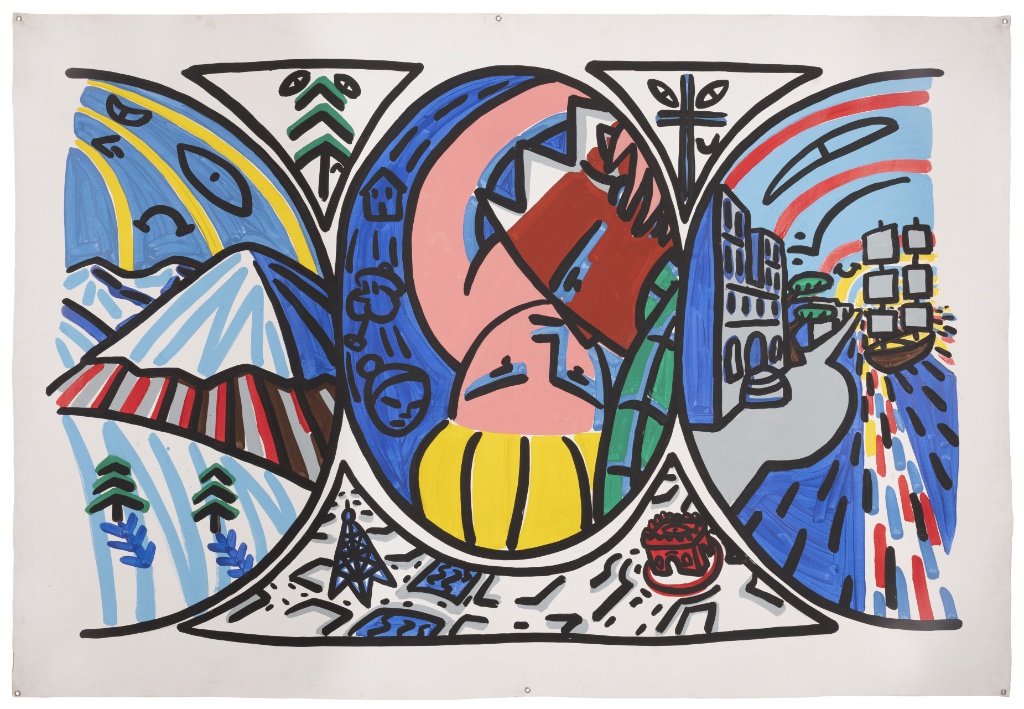
After seeing the François Boisrond retrospective at the Musée Paul Valéry in Sète, one has the impression that this French painter, little-known outside (or even in) his country, is like a sponge, soaking up everything he sees and urgently transposing it onto canvas, but always restlessly moving on in terms of style.
Early in his career, Boisrond (b. 1959), a charming bear of a man, was associated with the Figuration Libre movement along with his buddies Hervé Di Rosa, Rémi Blanchard and Robert Combas, who freely borrowed from comic-book and other popular art forms and painted their brightly colored works on whatever supports they could find, whether newspaper, cardboard or discarded wood panels.
Di Rosa and Combas continue to work in this mode, but Boisrond broke off in another direction in the late 1980s, finding his inspiration in daily life in Paris. As he puts it, “All of a sudden, I would see something that made me salivate … something I wanted to paint. It was like salivating over something you wanted to eat.” Anything was grist for his canvases: a busy street scene, a bustling art fair, a TV show, a man on a motor scooter, a sleeping child, an advertising panel in the street. Often images within images, they were painted in a more naturalistic style than the earlier black outlined comic-inspired pictures.

Boisrond then began a series of “transparencies” (inspired by a series painted by Francis Picabia in the 1920s), combining the personal with the universal by superimposing scenes from daily life over images from historical or popular sources, e.g, an ordinary living room superimposed over Sheherazade telling the king a story, or Manet’s “Déjeuner sur l’Herbe” with what appears to be the artist’s studio.

Next, he experimented with technology, using digital still cameras and high-definition film cameras to inform his work, and at the same time painting scenes in museums and art fairs, depicting the art of others in the late ’90s, a time when painting was more or less scorned at such events as the Venice Biennale.
He carried his interest in film technology over into his next series of works, which also seems to hark back to his roots: his father was the film director Michel Boisrond and his mother was the scriptwriter Annette Wademant. In these paintings, he took inspiration from the Jean-Luc Godard film Passion, in which the director created tableaux vivants of famous paintings like Ingres’ “The Turkish Bath.” So, here we have Boisrond making a painting of a filmmaker’s re-creation of a painting. Things get even more meta when you discover that the woman playing the naked bather in the film later became Boisrond’s wife. The artist used digital technology to analyze the colors in the film so he could reproduce them precisely in his paintings.

The final section of the show presents Boisrond’s paintings of tableaux vivants he set up himself and filmed, using family members and friends as models. Rushes from the films are used as preparatory studies for paintings inspired by the work of the Old Masters and the lives of the saints, once again combining the personal with universal references. In one series, he poses himself as Saint Francis in ecstasy; in another, his father-in-law poses as a near-naked Saint Jerome reading a book by French sociologist Pierre Bourdieu in a messy bedroom full of modern-day stuff, including a pair of skis, two weights and a tangle of electric cables.
It is always fascinating to see how an artist evolves over the course of a career. Boisrond seems to have a furious appetite for both the life around him and the life of the past, which he gobbles up, digests and pours out onto the canvas transformed.
Favorite